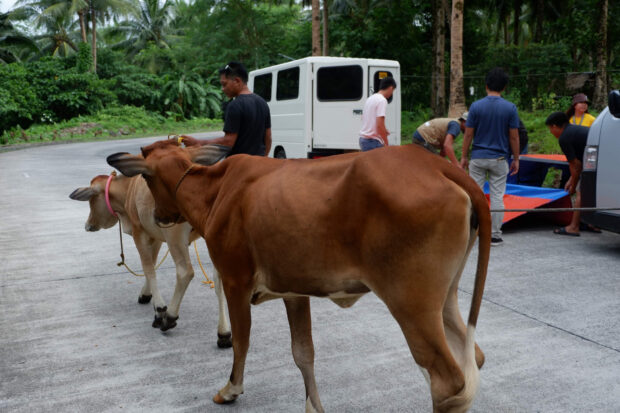
SAFER SPACE | Albay officials and farmers at Barangay San Roque in Malilipot town start gathering livestock to be taken to shelters away from the danger zone around of Mayon Volcano
on Saturday. (Contributed photo from the Albay Veterinary Office)
LEGAZPI CITY, Albay, Philippines — Aside from the evacuation of residents, the movement of farm animals to safer ground has also started in villages within the danger zone of the restive Mayon Volcano.
Godofredo dela Rosa, 63, who was forced to leave his hog farm in Mi-isi village in Daraga, Albay on Friday, said he was glad to learn that his 12 pigs would be following suit. “We left them in the backyard because we cannot bring them with us or to the lower slopes of the volcano,” Dela Rosa said in a phone interview on Saturday.
There are at least two animal shelters set up in neighboring Malilipot town—in Barangays San Roque and Calbayog—where Dela Rosa hopes to see his pigs soon. The task of moving livestock is mainly handled by the Provincial Veterinary Services (PVS). Pancho Mella, the Albay PVS chief, said his team was expecting to evacuate a first batch of about 130 goats, cows, and carabaos.
The provincial government earlier estimated that up to 10,000 animals had to be moved out of the permanent danger zone around Mayon, which covers a radius of 6 kilometers.
“We did not join the evacuation of people (on Friday) because we first had to first preposition supplies (at the animal shelters) like feeds, water, and grass,” Mella said.
The animals are to be moved on foot and assembled first at a certain pickup point, before being brought to the shelters that are at least a kilometer away from the danger zone.
Abandoned pets like dogs and cats were not yet included in the evacuation plan.
In an earlier interview, Lovella Guarin, information officer of the Department of Agriculture (DA) Bicol, said another animal shelter had been prepared at the Albay Breeding Center in Camalig town. “The research outreach station is big [enough to] house the animals of the farmers. We have personnel to take care of them wherein foods and vitamins will be given,” Guarin said.
9,000 people moved
Meanwhile, Gremil Alexis Naz, spokesperson for the Office of Civil Defense Bicol, said Albay province had evacuated 2,638 families, or 9,314 persons, in Camalig, Ligao City, Daraga, Guinobatan, Malilipot, and Tabaco City as of Saturday morning.
The Philippine Institute of Volcanology and Seismology (Phivolcs) said a new lava dome had formed at the volcano’s summit. Paul Karson Alanis, a resident volcanologist at Phivolcs Legazpi, said it was still hard to tell if the new dome was caused by new magma or just remnants of the last eruption in January 2018.
“We can say that there’s a possibility [of] lava flow because this [new lava dome] is hotter and more liquid than the old and solidified lava dome,” Alanis said.
Phivolcs also recorded one volcanic earthquake and 59 more “rockfall events” since the last monitoring period on Friday, as well as a “fair crater glow,” or a pronounced brightness at the summit strong enough to be detected by the naked eye.
Aid funds on standby
Alert level 3 has been in effect over the volcano’s danger zone since June 8, after Philvolcs warned of a possible “hazardous eruption” within weeks or even days.
President Ferdinand Marcos Jr. said a P114-million quick response fund from the Department of Social Welfare and Development was already on standby for the evacuees. “With Albay province under a state of calamity, I am reminding the Bicolanos to follow the recommendations and evacuation instructions of your local government unit to ensure everyone’s safety,” Mr. Marcos said in a social media post on Saturday.